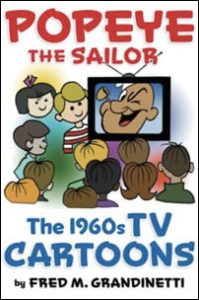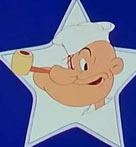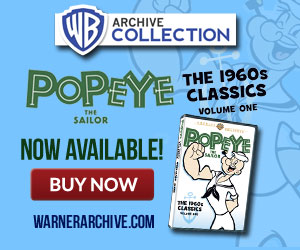“I’m so happy to have this. I’d rather read about these cartoons then to ever have to watch them again. Fred has rewatched them all so I (or any of you) never have to!” – Jerry Beck, Cartoon Research.
When one normally writes a book on a film property hopefully the reader is enticed to take another look at the subject matter. Although the reviews of my publication, Popeye the 1960’s TV Cartoons by Bear Manor Media, have been received generally good they echo Jerry Beck’s sentiment.
Many episodes were not animated on a shoe string budget but torn laces! It is these cartoons which has given this series of 220 episodes such a bad reputation. Yet, there are still many good entries with fine animation and entertaining stories.
In order to get the reader to take another look at the cartoons I have added a ‘Best of’ section to future printings of the book. This type of addition is usually controversial. These are episodes which stood out in my mind even as a child. The animation, in each, is more than satisfactory, and many have interesting roots coming from Popeye’s creator, E.C. Segar.
 Paramount Cartoon Studios, was one of six places chosen by producer Al Brodax, to crank out more color Popeye episodes to be syndicated by King Features. King also syndicated the Thimble Theatre comic strip featuring the spinach-eating sailor, Olive Oyl, Wimpy, Swee’pea and The Sea Hag. Seymour Kneitel served as both director and writer on Paramount’s contribution to the series. These episodes are generally considered to be the best of the lot.
Paramount Cartoon Studios, was one of six places chosen by producer Al Brodax, to crank out more color Popeye episodes to be syndicated by King Features. King also syndicated the Thimble Theatre comic strip featuring the spinach-eating sailor, Olive Oyl, Wimpy, Swee’pea and The Sea Hag. Seymour Kneitel served as both director and writer on Paramount’s contribution to the series. These episodes are generally considered to be the best of the lot.
In the additional section of my book, it is pointed out Kneitel took long storylines from Thimble Theatre daily strips, turning each into entertaining adventures running a little over five minutes. Kneitel’s Me Quest for Poopdeck Pappy and Myskery Melody, for example, utilized the same dialogue and plots taken from daily strips written by E.C. Segar. Sunday page gags, by Segar, were also turned into complete cartoons as in the case of It Only Hurts When They Laugh and Poppa Popeye.
 However, Kneitel also utilized material from the Sunday strip, written by Segar’s successor, Tom Sims. The cartoon, Wimpy the Moocher, is based upon two Sunday pages from 1939. In one Wimpy tricks Rough House into thinking he has found a pearl in an oyster and tries the same trick with chef, Geezil. Geezil made his only animated appearance in this episode.
However, Kneitel also utilized material from the Sunday strip, written by Segar’s successor, Tom Sims. The cartoon, Wimpy the Moocher, is based upon two Sunday pages from 1939. In one Wimpy tricks Rough House into thinking he has found a pearl in an oyster and tries the same trick with chef, Geezil. Geezil made his only animated appearance in this episode.
One of the highlights of this series, as opposed to the theatricals, was seeing more characters used from the comic strip.
Additionally, personnel who worked on particular cartoons are highlighted.
I hope Popeye fans will take a look at the episodes chosen in this updated edition and see how wrong or right I was in their selection. Considering their financial success and longevity they are worth another look.



 Fred M. Grandinetti is the author of five Popeye related books and a number of articles on the one-eyed sailor. Other topics by Grandinetti published in newspapers, magazines and the web include The original Batwoman (Kathy Kane), I Dream of Jeannie, Tara King (from The Avengers), The Mighty Hercules, the Batman television series and Bozo the Clown. Fred, along with Cuyle Carvin and David Hudon, produced the anti-bullying graphic novel, Different Worlds, Best of Friends. Fred is also the host of the award-winning cable access series, Drawing With Fred.
Fred M. Grandinetti is the author of five Popeye related books and a number of articles on the one-eyed sailor. Other topics by Grandinetti published in newspapers, magazines and the web include The original Batwoman (Kathy Kane), I Dream of Jeannie, Tara King (from The Avengers), The Mighty Hercules, the Batman television series and Bozo the Clown. Fred, along with Cuyle Carvin and David Hudon, produced the anti-bullying graphic novel, Different Worlds, Best of Friends. Fred is also the host of the award-winning cable access series, Drawing With Fred.

























So do these four cartoons represent the “best of” the series? I admit I laughed out loud when the Sea Hag gave her name as “Ethel Merlin”.
I never saw the KFS Popeyes when I was growing up, having been devoted to the Fleischer and Famous versions and unwilling to accept any substitutes (e.g., Brutus for Bluto). In recent years, however, I’ve rather enjoyed the ones that periodically crop up here in Charles Gardner’s Animation Trails column. If I can now see the flaws in the Trans-Lux cartoons of the same vintage, which I adored as a child, then maybe I have the maturity to recognise the virtues in the KFS cartoons that I once dismissed.
Congratulations on getting a second printing, and for updating it with new material. Thanks also for documenting this often-ignored chapter in Popeye’s history, and I hope it garners greater attention as we approach his centenary.
Great book. Better than the first!
In the 80’s I never thought I’d ever say this in my entire life –
but I’d much rather watch a 1960’s Popeye TV cartoon again, than watch the latest Disney animated movie (Wish) again.
Same here!
I would disagree that bit. Though, I did wish I knew what went wrong.
Wasn’t some of the 60s popeye shorts animated from the Gene Deitch animation studio from Czechoslovakia? Just asking….
Yes, they were. Deitch’s studio also did King Features’ “Krazy Kat” cartoons during the same time.
Was there a video of that Brewster color Demo reel
I’m referring to this
https://cartoonresearch.com/index.php/mendelssohns-spring-song-1931/
This is the Popeye I grew up on and enjoyed, not yet realizing he had a former life with Fleisher/Paramount. Of course, I loved those too when I saw them, but I never liked Hanna-Barbera’s take. I bought a good dvd set of 85 King Features era shorts to relive my happy childhood memories of Brutus, The Jeep, Rough House, Sea Hag and the rest.
I always sort of liked the KFS Popeyes, or at least appreciated them for what they are. Off the top of my head, the Mt. Idiot one with the Dink Trout sounding Abominable Snowman is probably my favorite, even if the designs in it are a bit odd (Larry Harmon did that one I’m 90% sure)
Beck seems to not like alot of the KFS cartoons, he didn’t like Cool McCool either (which I DO take issue with, aargh!)
Reading your book made me appreciate them a lil bit more, besides the “best of” list, is anything else different in this new printing?
The ‘best of’ section contains information regarding the comic strip origins of several episodes (with Segar’s illustrations pictured as reference). Also background information on many cartoons.
Do we have a publication date for the second printing?
The KFS cartoons are to be avoided at all costs.
Not all of them. Besides the Paramount ones (note that Jerry skipped the leprechaun cartoon they did and went straight to the three inferior shorts by Jack Kinney’s team in the Youtube), I thought the ones by Gerald Ray (whose studios would introduce us to King Leonardo and Total Television that same year), and to a lesser extent, the ones by Rembrandt and Halas & Batchelor were quite good/decent.
I am in total agreement with you. These are unwatchable .
When Grandinetti says George Geezil made “his only animated appearance” in the TV episode “Wimpy the Moocher,” I assume he’s referring to Geezil appearing on the TV series. The character appeared in two Fleischer cartoons: Olive can be seeing walking out with Geezil at the end of “A Clean Shaven Man,” and he’s a furrier at the beginning of “Olive’s Boithday Presink,” (though in “Thimble Theater” itself, he was a shoemaker.)
The Kinney Popeyes at least have imaginative title cards, with THE BLACK KNIGHT especially striking. Too bad there’s no positive correlation between title quality and episode quality (as is even more evident with POPEYE AND THE GIANT).
It’s encouraging when an author reissues a book thoroughly revamped rather than simply releasing the old book with some new stuff tacked on.
As I may have said once or twice, you try producing theatrical quality animation with one third the budget in one fourth the time. Looking at it that way, it’s a little surprising these cartoons are as good as they are; hating them is like hating a skateboard for not being a Rolls Royce (or a Kia, considering the latter theatrical Popeyes). In fact, the theatrical cartoons the former Famous Studios was producing at the time weren’t any better than their TV Popeye cartoons; same with the Gene Dietch-produced theatrical Tom and Jerrys. At least the King Features Popeyes made use of Thimble Theater characters egregiously overlooked by both Fleischer and Famous, which focused primarily and rather tediously on Popeye and Bluto fighting over Olive Oyl, or bringing in “new” characters like Shorty and the so-called nephews (Jack Kinney did bring in a version of the Reluctant Dragon from the Disney feature and renamed him Silky). Many of the stories were interesting, and would have made great cartoons fully animated. But admittedly not many of them stand up to repeat viewings, although I could have picked a better “best of” for the DVD set. (I look forward to reading the book’s “best of.”)
I bet when the 1959 features “Sleeping Beauty” and “1001 Arabian Nights” were in production the artists had no idea that a year later they’d be working on limited animation Popeye cartoons.
I respectfully disagree with Hans regarding the theatrical Popeyes not any better than the KFS Popeyes. From the visuals to the fluidity of movement that was flat out nonexistent in the KFS, there is a distinguishable difference between the two. It seems mind boggling to me how anybody can’t, or won’t acknowledge that.
Just drek. I hated when black and white Popeyes and early Famous were shunted aside for this crap, just because it was in color. I hated when that f-ing horse with the feather came on the screen. (What the hell does it mean, anyway?) There was a transition period where they had these mixed in with the classic Popeyes. We’d go out and play. If you heard the KFS music you didn’t bother. If you heard Fleischer, you ran inside to watch. I can’t imagine an entire book written on this subject when there’s never been such a detailed publication on the Fleischer Popeyes, where true greatness reigned.
The KFS logo was an image of the Greek hero Bellerophon astride the winged horse Pegasus. (They were technically half-brothers, both having been sired by Poseidon.) In Greek art, Bellerophon is normally shown carrying a spear; here, however, he’s holding a quill pen, presumably because the syndicate dealt with cartoonists who worked with pen and ink.
So what’s the date the new edition was published? Amazon has a book from 2022. Is the new edition newer than that?
Where can I buy the new edition?